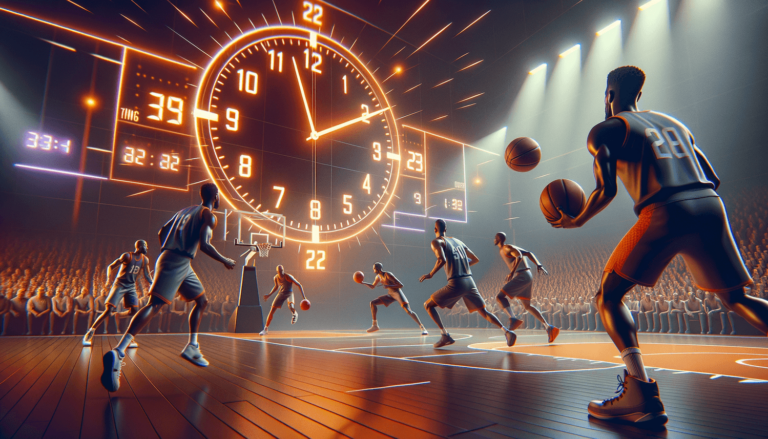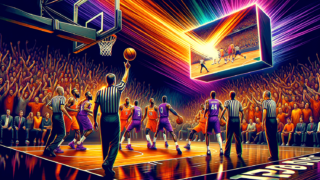
Two-Minute Foul Rule in Basketball: What It Means
Written by: Basketball Universe
Last updated:

Step up your hoops knowledge with a deep dive into the fascinating world of the Two-Minute Foul Rule in basketball! As die-hard basketball fans and curious newcomers alike, there’s always more to learn about this fast-paced sport. In this blog post, we’ll unravel the mystery surrounding the rule, its history, and its impact on the game we all love. Prepare to wow your friends at your next pick-up game or debate, and be your group’s resident expert on the Two-Minute Foul Rule in basketball. So, lace up your sneakers, clear the court, and let’s discover what this intriguing rule means for our favorite game!
Two-Minute Foul Rule in Basketball: What It Means
The Two-Minute Foul Rule in basketball refers to the change in team foul penalties during the last two minutes of a quarter or half. Within this period, a team is allowed only one common foul. If they commit more fouls, the opposing team is rewarded with free throws, even if the fouled team is not yet in the bonus. The rule aims to speed up the game’s ending, reduce intentional fouling, and encourage more strategic gameplay.
A Brief History of the Two-Minute Foul Rule
The Two-Minute Foul Rule has evolved over the years, largely in response to changing gameplay strategies and the desire to keep the game engaging for both players and fans. Let’s take a quick journey back in time to understand how this rule came to be.
The Early Days of Basketball
When Dr. James Naismith invented basketball in 1891, fouls were a relatively minor part of the game. Over the years, as the sport grew more competitive and teams sought every advantage, strategies like intentional fouling emerged. These fouls disrupted the flow of the game, slowing it down and leading to extended end-of-game scenarios where teams would continually foul to stop the clock and create more scoring opportunities.
NBA’s Response to Fouling Strategies
To combat these tactics, the NBA introduced several changes throughout the 20th century, including the bonus free throw rule in 1954, which awarded extra free throws after a certain number of team fouls. However, late-game intentional fouling persisted, and in the 1970s, the NBA implemented the Two-Minute Foul Rule, dramatically altering how fouls were penalized in the last two minutes of each quarter and half.
Understanding the Two-Minute Foul Rule: Mechanics and Penalties
Now that we’ve seen how the Two-Minute Foul Rule came to be let’s dive into its mechanics and how it impacts the game. The rule applies during the last two minutes of each quarter or half, and its penalties differ from those outside this timeframe.
Team Fouls Outside the Two-Minute Mark
Outside the last two minutes, a team can commit up to four common team fouls (non-shooting fouls or away from the ball) without additional penalties. Starting from the fifth team foul, the fouled team enters the “bonus,” where, upon being fouled, they’re awarded free throws or other associated penalties under the rules of the game.
Two-Minute Foul Rule Mechanics and Penalties
During the last two minutes of every quarter, the Two-Minute Foul Rule comes into play. During this time, it doesn’t matter if a team is in the bonus or not; once they’ve committed one common team foul, any subsequent foul will result in free throws for the opposing team. Essentially, teams have a single “foul to give” during the last two minutes of the quarter.
It’s essential to note that this rule doesn’t affect individual player fouls, and the penalties for technical, flagrant, and personal fouls remain unchanged during this period.
Strategic Implications of the Two-Minute Foul Rule
By changing the way fouls are penalized during the last two minutes of each period, the Two-Minute Foul Rule profoundly impacts a team’s strategy. Let’s see how this potentially alters tactics, on-court decisions, and the overall pace of the game.
Deterring Intentional Late-Game Fouling
One of the crude yet effective strategies employed by teams trailing late in games is intentional fouling. Fouling stops the clock and forces the opposing team to shoot free throws, which, if missed, can potentially provide the fouling team with a chance to score and reduce the deficit.
By ensuring that each foul committed in the final two minutes awards free throws to the opponent, the Two-Minute Foul Rule deters this tactic. Teams must be more cautious about fouling in the final moments of the game, as they risk offering their opponents easy points at the free-throw line.
Increasing Overall Game Pace
When teams continuously foul during the last minutes of the game, it often results in an extended, slow-paced ending. With the Two-Minute Foul Rule in place, the game moves at a brisker pace, keeping fans engaged till the end. Fewer stoppages result in smoother gameplay and less stalling, providing a more enjoyable experience for players and spectators alike.
Forcing Teams to Rely on Good Defense
The Two-Minute Foul Rule pushes teams to strengthen their defense instead of relying on fouls to interrupt the opposing team’s rhythm. Teams must adapt their strategies, employ tighter man-to-man coverage, and maintain effective communication to excel in the final moments of the game. This results in a more intense and exciting matchup, and defense becomes a critical part of a team’s success.
Incorporating the Two-Minute Foul Rule Into Your Basketball Knowledge
As a basketball enthusiast, it’s important to keep expanding your knowledge of various rules and tactics to enhance your appreciation of the sport. The Two-Minute Foul Rule is a key aspect of basketball rules, and understanding its implications can help you in several ways.
Improve Your Pick-Up Games and Debates
Being well-versed in the Two-Minute Foul Rule enables you to strategize better during pick-up games and potentially deliver clutch stops when needed. This understanding also allows you to participate in more in-depth debates with fellow basketball aficionados, comparing different game strategies and discussing how the rule affects late-game decision-making.
Develop a Deeper Appreciation for the Game
When you understand the intricacies of the sport and the impact of specific rules, you can enjoy the game on a whole new level. The Two-Minute Foul Rule is just one example of how rules shape the game and influence team strategies. By learning about this and other rules, you’ll find new ways to enjoy and appreciate the art of basketball, whether you’re watching from the sidelines or shooting hoops yourself.
Notable Moments and Controversies Surrounding the Two-Minute Foul Rule
When rules change the dynamics of a game, they can also lead to memorable moments and controversy. The Two-Minute Foul Rule has had its fair share of both, with many instances over the years where this rule came into the spotlight.
Close Game Finishes
The last two minutes of a basketball game can often be nail-biting, with narrow leads and high suspense. The Two-Minute Foul Rule has played a significant role in various close games by dictating how teams defend and approach foul trouble. Knowledgeable teams have taken advantage of this rule to create scoring opportunities and overturn late-game deficits, resulting in some unforgettable moments for both players and fans.
Experimenting with the Two-Minute Foul Rule in Other Leagues
Basketball leagues around the world often look to the NBA for guidance on rules and gameplay innovations. The Two-Minute Foul Rule is no exception, with other leagues exploring how this rule can enhance their own gameplay and create more entertaining experiences for fans.
Adopting the Rule in College Basketball
After the NBA’s success with the Two-Minute Foul Rule, college basketball leagues in the United States began considering its adoption. Though the NCAA has not officially implemented the rule, individual conferences have experimented with variations of it during preseason games and tournaments. This experimentation is part of a broader movement towards adopting some NBA-style rules across college basketball to maintain consistency and improve the game’s overall pace.
Impact on International Leagues
International basketball leagues are also taking note of the Two-Minute Foul Rule’s effect on the NBA. Many leagues in Europe, South America, and Asia are experimenting with similar rules to speed up the game, deter intentional fouling, and enhance competitiveness. By adopting and adapting this rule, these leagues hope to provide fans with faster-paced, more engaging basketball experiences.
Wrapping Up: The Two-Minute Foul Rule’s Role in Basketball
From its inception as a means to counter intentional fouling to its wide-reaching impact on basketball strategy today, the Two-Minute Foul Rule remains a vital part of the game. It has changed the way teams approach late-game scenarios, encouraged greater emphasis on effective defense, and ensured a faster pace during the game’s final moments. By understanding and appreciating this rule, you not only enhance your own gameplay but also gain a deeper understanding of the diverse array of strategies and skills that make basketball such a captivating sport.
Analyzing the Two-Minute Foul Rule’s Effect on NBA Statistics
Numbers don’t lie, and that’s why it’s important to consider the statistical impact the Two-Minute Foul Rule has had on the NBA. Examining the data can offer insights into how players and teams adjusted their strategies and overall performance following its implementation.
Impact on Free Throw Attempts
One of the more notable effects of the Two-Minute Foul Rule has been a slight decrease in free throw attempts during the last two minutes of each period. This implies that teams are more cautious in their fouling strategies, avoiding fouls that lead to free throw opportunities and focusing more on their defense. The outcome is fewer stoppages and a faster-paced conclusion to games.
Impact on Scoring
By reducing intentional fouls during the last two minutes, the Two-Minute Foul Rule has affected the overall scoring patterns. Though the decrease in free throws doesn’t have a significant impact on total points scored, it does shift the focus towards scoring from the floor. Players are relied upon to make effective offensive plays and clutch shots, leading to more incredible highlight-worthy moments and dynamic finishes in games.
Exploring Where the Two-Minute Foul Rule Doesn’t Apply
Though the Two-Minute Foul Rule has undoubtedly been instrumental in the NBA’s evolution, it’s worth noting that not all leagues follow this rule. Here’s a overview of where this rule doesn’t apply and how the game varies as a result.
Youth and Amateur Basketball Leagues
In youth and amateur basketball leagues, the focus is often more on skill development and fundamental gameplay, rather than on competitive strategies. As a result, many of these leagues have not adopted the Two-Minute Foul Rule. Instead, they emphasize rules that promote sportsmanship and ensure a safe playing environment for young athletes.
Differences in International Rules
While the Two-Minute Foul Rule has been influential across various international leagues, the FIBA (International Basketball Federation) does not have an identical rule in place. The FIBA does, however, limit the number of team fouls before bonus free throws are awarded, resulting in a somewhat similar system, albeit with slightly different mechanics and penalties.
Debating the Effectiveness of the Two-Minute Foul Rule
Despite its widespread adoption and impact on gameplay, the Two-Minute Foul Rule remains a topic of debate amongst basketball fans, players, and analysts. Let’s explore a few key points that arise as part of these discussions.
Is Intentional Fouling Completely Deterred?
While the Two-Minute Foul Rule has reduced instances of intentional fouling in late-game situations, it has not eliminated it entirely. Cases still arise where coaches instruct players to purposely commit a foul, especially when the opposing team has a weaker free-throw shooter. Debates continue on whether additional rule changes or adjustments are needed to further discourage intentional fouling in these situations.
Pace of Game vs. Tactical Approach
While the Two-Minute Foul Rule aims to increase the pace of games and limit interruptions, some argue that the rule overly restricts tactical flexibility. Situations where intentional fouling is employed as a strategic move (even if it slows down the game) are part of basketball’s inherent appeal for these fans and enthusiasts.
In conclusion, though the Two-Minute Foul Rule has proven influential in shaping modern basketball, its effectiveness and impact remain a subject of discussion and debate. As the game continues to evolve and new strategies emerge, rules like this will undoubtedly be examined, adjusted, or expanded upon to ensure basketball remains an enthralling sport for players and fans alike.
Frequently Asked Questions on the Two-Minute Foul Rule
As with any basketball rule or strategy, the Two-Minute Foul Rule may generate several questions from curious learners and seasoned basketball enthusiasts looking to deepen their understanding. To help further clarify this exciting and dynamic rule, we’ve compiled a list of frequently asked questions and their succinct answers.
1. What is the Two-Minute Foul Rule in basketball?
The Two-Minute Foul Rule is a regulation affecting team fouls in the last two minutes of each quarter or half. During this time, teams have one “foul to give.” If they commit more than one common team foul, the fouled team is awarded free throws, regardless of whether they are in the bonus or not.
2. When was the Two-Minute Foul Rule introduced?
The Two-Minute Foul Rule was introduced in the 1970s by the NBA to combat persistent intentional fouling and to speed up the last minutes of the game.
3. How many fouls are allowed in the last two minutes of a basketball game?
During the last two minutes of a basketball game, teams are allowed one common team foul without incurring additional penalties. Upon committing further fouls, the opposing team is automatically awarded free throws.
4. How does the Two-Minute Foul Rule affect late-game strategy?
The Two-Minute Foul Rule deters intentional fouling during the end of the game, forcing teams to rely more on good defense and effective offensive plays to win the game rather than attempting to stop the clock through fouls.
5. Are the penalties for other types of fouls affected by the Two-Minute Foul Rule?
No, the Two-Minute Foul Rule only affects common team fouls. Technical, flagrant, and personal fouls are not impacted by the rule and maintain their standard penalties during this time.
6. Has the rule entirely stopped intentional fouling in the final minutes?
Though the Two-Minute Foul Rule has significantly reduced instances of intentional fouling, it hasn’t eliminated it entirely. Teams may still resort to intentional fouls in some situations, particularly when the fouled player is a weak free-throw shooter.
7. Does the NCAA use the Two-Minute Foul Rule?
The NCAA has not officially adopted the Two-Minute Foul Rule, but individual conferences have experimented with variations of the rule during preseason games and tournaments.
8. Do FIBA and international leagues use the Two-Minute Foul Rule?
FIBA does not have an identical rule, but it does have a limit on the number of team fouls before awarding bonus free throws, which creates similar mechanics and penalties. Some international leagues have experimented with the rule to achieve faster-paced and more engaging gameplay.
9. How has the Two-Minute Foul Rule affected game statistics?
The rule has resulted in a small decrease in free throw attempts during the last two minutes of each period, suggesting that teams are more cautious about fouling. The faster pace has shifted focus towards scoring from the floor, leading to more dynamic finishes in games.
10. Are there any alternative rule proposals to replace the Two-Minute Foul Rule?
There have been various proposals and discussions on alternative rules to further deter intentional fouling, but no specific rule has gained widespread acceptance to replace the Two-Minute Foul Rule as of yet.
Featured Posts
- No pillar pages found.





